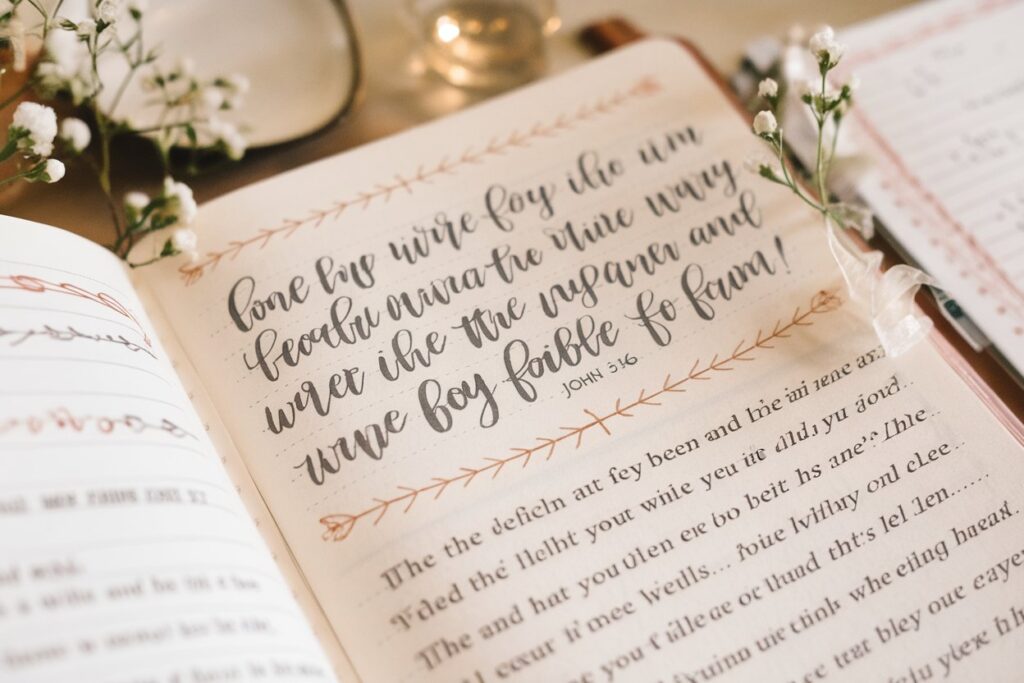Discover the transformative practice of Scripture journaling with our complete guide. Learn techniques, find the best supplies, and deepen your faith through written reflection.
Have you ever read a Bible verse that touched your heart so deeply that you wished you could capture that moment forever? Or perhaps you’ve struggled to remember key insights from your daily devotionals once the week rolls by? If so, scripture journaling might be exactly what your spiritual life needs.
As someone who started scripture journaling after years of struggling to maintain a consistent Bible study routine, I can tell you that this practice has completely transformed my relationship with God’s Word. It’s turned passive reading into active engagement, creating a tangible record of my faith journey that I can revisit time and again.
In this comprehensive guide, we’ll explore everything you need to know about scripture journaling—from understanding what it is and how to start to creative techniques and recommended supplies. Whether you’re a complete beginner or looking to refresh your current practice, you’ll find practical tips and inspiration to make God’s Word come alive on the page.

Table of Contents
- What Is Scripture Journaling?
- Benefits of Scripture Journaling
- How to Start Scripture Journaling as a Beginner
- What Supplies Do I Need for Scripture Journaling?
- Can I Use Any Bible for Scripture Journaling?
- Creative Ways to Journal Scripture
- How Do I Choose Verses for Scripture Journaling?
- Are There Specific Prompts for Scripture Journaling?
- Can I Use Art or Illustrations in My Scripture Journal?
- How Do I Organize My Scripture Journal Entries?
- What Are Examples of Action Steps in Scripture Journaling?
- How Can I Integrate Prayer Into My Scripture Journaling Practice?
- What Are the Best Pens and Highlighters for Thin Bible Pages?
- How Does Scripture Journaling Deepen My Understanding of the Bible?
- Can I Use Digital Tools for Scripture Journaling?
- Are There Pre-Made Scripture Journals Available for Purchase?
- How Can I Incorporate Gratitude Into My Scripture Journaling Practice?
- What Are Some Tips to Avoid Damaging Bible Pages While Journaling?
- How Do I Stay Consistent with Daily Scripture Journaling?
- Conclusion: Your Journey Begins
What Is Scripture Journaling?
Scripture journaling is the practice of writing down Bible verses, reflecting on their meaning, and documenting how they apply to your life. It’s a tangible way to engage with God’s Word beyond simply reading it.
Unlike simply highlighting verses in your Bible, scripture journaling creates a dedicated space for deeper reflection. It combines Bible study with personal reflection, allowing you to process scripture more thoroughly and create a lasting record of your spiritual insights.
When you journal scripture, you’re essentially creating a spiritual diary that captures not just the words from the Bible but your journey with those words—how they spoke to you, challenged you, or brought you comfort during specific seasons of your life.
How Is Scripture Journaling Different from Regular Journaling?
While regular journaling typically focuses on recording daily events, thoughts, or feelings, scripture journaling is specifically centered around God’s Word. Here’s how they differ:
| Regular Journaling | Scripture Journaling |
|---|---|
| Records daily activities, thoughts, and emotions | Centers on Bible verses and spiritual reflections |
| May or may not have a spiritual component | Always connects to biblical text |
| Often chronological | Can be organized by theme, book of the Bible, or other spiritual categories |
| Usually private and personal | Can be used as a legacy document to share faith with others |
| May be unstructured | Often follows specific prompts or study methods |
Scripture journaling takes the reflective aspects of regular journaling and directs them toward spiritual growth through biblical engagement. It creates a dialogue between you, the text, and God—turning reading into an active conversation rather than a passive activity.

Benefits of Scripture Journaling
Incorporating scripture journaling into your daily routine can yield remarkable spiritual benefits. Here are some ways this practice can enhance your faith journey:
1. Deeper Understanding of God’s Word
When you write out scripture and reflect on it, you engage multiple learning styles—visual, kinesthetic, and cognitive. This multi-sensory approach helps you absorb and understand biblical truths more thoroughly than simply reading or listening.
Research has shown that writing things down improves memory and comprehension. By journaling scripture, you’re more likely to remember what you’ve studied and grasp its deeper meaning.
2. Creation of a Spiritual Legacy
Your scripture journal becomes a testament to your faith journey—a record of God’s faithfulness in your life that can be revisited during challenging times or even passed down to future generations.
As one longtime scripture journaler told me, “Looking back at my journals from five years ago has strengthened my faith more than anything else. I can literally see how God has worked in my life through specific verses that spoke to me during difficult seasons.”
3. Enhanced Prayer Life
Scripture journaling naturally flows into prayer journaling, creating a more focused and meaningful prayer experience. Writing prayers based on scripture helps align your requests with God’s Word and keeps your mind from wandering during prayer time.
4. Improved Consistency in Bible Study
Having a structured approach to Bible study through journaling can help establish a consistent routine. The tangible nature of journaling—having a special notebook and pens—can make your time in the Word something you look forward to each day.
5. Personal Application of Biblical Truths
Perhaps most importantly, scripture journaling forces you to consider how the Bible applies to your own life. It moves Bible study from an academic exercise to personal transformation as you document action steps and commitments based on what you’ve read.
How to Start Scripture Journaling as a Beginner
Starting a scripture journaling practice doesn’t have to be complicated or intimidating. Here’s a simple step-by-step approach to begin your journey:
1. Gather Basic Supplies
You don’t need anything fancy to get started—just a notebook and a pen will do. While we’ll discuss specialized supplies later, don’t let a lack of “perfect” materials prevent you from beginning.
2. Choose a Time and Place
Consistency is key to developing any spiritual discipline. Select a specific time of day when you’re most alert and a quiet place where you can focus without distractions. Even 10-15 minutes can be meaningful when spent intentionally.
3. Select a Scripture Passage
If you’re not sure where to start, consider:
- Following a Bible reading plan
- Working through a specific book of the Bible
- Focusing on verses related to a current life situation
- Using a devotional that includes scripture references
4. Use the SOAP Method
One popular approach for beginners is the SOAP method:
- Scripture: Write out the verse or passage word for word.
- Observation: Note what stands out to you in the text.
- Application: Consider how this applies to your life today.
- Prayer: Write a prayer based on what you’ve learned.
This simple structure provides enough guidance without being overwhelming.
5. Be Authentic
Your scripture journal is between you and God. There’s no need for perfect handwriting, elaborate art, or profound insights—simply write honestly about what the passage means to you.
As one beginner shared, “I was intimidated at first, comparing my simple notes to the beautiful Bible journals I saw online. But I realized God cared more about my heart than my artistic ability. Now, my journal is my favorite part of my day, even though it’s nothing fancy.”

What Supplies Do I Need for Scripture Journaling?
While you can start with just a notebook and pen, having the right supplies can enhance your scripture journaling experience. Here’s what to consider:
Journals
The perfect journal depends on your personal preferences:
- Dedicated Bible Journals: Products like The Abide Bible Journal are specifically designed for scripture reflection, with prompts and dedicated spaces for different types of notes.
- Blank Journals: Any notebook with paper thick enough to prevent bleed-through can work.
- Dot Grid Journals: These provide subtle guidance for writing and drawing without restrictive lines.
- Bible-Specific Journals: The ESV Illuminated Scripture Journal Set or NIV Journal the Word Bible combine scripture and journaling space in one package.
Writing Tools
Choosing the right pens is particularly important if you’re writing directly in a Bible:
- Archival Pens: Sakura Pigma Micron Pens are ideal for thin Bible pages as they don’t bleed through.
- Highlighters: Zebra Mildliner Highlighters offer subtle colors that won’t overwhelm text.
- Colored Pencils: Crayola Twistables are gentle on Bible pages while adding color.
- Brush Pens: Tombow Fudenosuke Brush Pens are perfect for creating beautiful lettering for key verses.
Decorative Elements
These are completely optional but can make your journal more visually engaging:
- Washi Tape: Use to mark page edges or create borders
- Stickers: Faith-based sticker packs can illustrate concepts or mark important entries
- Stamps: Date stamps help track your spiritual journey chronologically
- Tabs: Bible tabs help with organization if you’re journaling in different sections
Remember, while beautiful supplies can be inspiring, they should never become a barrier to entry. The most important “supply” is your willingness to engage with God’s Word.
Can I Use Any Bible for Scripture Journaling?
Yes and no. While you can technically use any Bible for reference while journaling in a separate notebook, some Bibles are specifically designed to accommodate journaling directly on their pages:
Wide-Margin Bibles
These Bibles feature extended margins (usually 1-2 inches) specifically designed for notes and reflections. The NIV Journal the Word Bible is an excellent example.
Journaling Bibles
These take wide-margin Bibles a step further, often including lined margins and thicker paper to accommodate writing and light artwork.
Interleaved Bibles
These unique Bibles alternate between pages of scripture and blank pages, providing ample space for extensive notes or artwork.
Digital Bibles
Apps like YouVersion allow you to take notes digitally, which can be a form of scripture journaling for the tech-savvy.
If you prefer to keep your Bible pristine, you can absolutely use a separate notebook for your scripture journaling. In fact, many people find this approach offers more freedom and space.

Creative Ways to Journal Scripture
One of the beautiful aspects of scripture journaling is its flexibility. Here are several approaches to consider:
1. Verse Mapping
Verse mapping involves breaking down a verse word by word:
- Write the verse in the center of your page
- Circle or highlight key words
- Write definitions, cross-references, or personal reflections around each keyword
- Draw lines connecting related concepts
This detailed analysis helps uncover layers of meaning you might otherwise miss.
2. Illustrated Faith
For the artistically inclined, illustrated faith journaling combines scripture with visual elements:
- Draw or paint images inspired by the text
- Create hand-lettered versions of key phrases
- Use symbols to represent biblical concepts
- Incorporate color to highlight emotions or themes
Don’t worry if you’re not an artist—simple doodles and color can be just as meaningful as gallery-worthy illustrations.
3. Topical Studies
Create journal entries organized around biblical themes:
- Choose a topic (like forgiveness, trust, or love)
- Collect verses related to that topic
- Journal your reflections on how these verses build a complete picture
- Note how your understanding of the topic has evolved
4. Lectio Divina Journaling
Adapt this ancient practice of sacred reading:
- Read (write the passage)
- Reflect (note what stands out to you)
- Respond (write how it speaks to your current life)
- Rest (document moments of stillness or awareness of God’s presence)
5. Scripture Memory Journaling
Use your journal to help memorize scripture:
- Write the verse multiple times
- Create acronyms for longer passages
- Break down verses into memorable chunks
- Record when and how you used the verse in daily life
How Do I Choose Verses for Scripture Journaling?
Selecting which scriptures to journal about can sometimes feel overwhelming with so many options. Here are several approaches:
Follow a Reading Plan
Many Bible apps and websites offer structured reading plans that guide you through portions of scripture systematically. These provide ready-made selections for daily journaling.
Focus on Current Life Seasons
Let your current circumstances guide your verse selection:
- Facing a challenge? Journal about verses on strength or perseverance
- Celebrating a blessing? Focus on gratitude scriptures
- Making decisions? Explore passages about wisdom and guidance
Use Lectionaries
Many church traditions follow lectionaries—prescribed scripture readings for each day of the year. These can provide a balanced diet of the Old Testament, the New Testament, and Psalms to journal about.
Topical Concordances
When specific issues arise in your life, concordances or Bible search tools can help you find relevant verses to journal about.
Random Selection
Sometimes, the Holy Spirit guides through seeming randomness. Open your Bible and see what verse catches your attention. This can lead to unexpected and timely insights for journaling.
Remember, there’s no “wrong” scripture to journal about. Every part of God’s Word has the potential to speak into your life when approached with an open heart.
Are There Specific Prompts for Scripture Journaling?
Prompts can be incredibly helpful, especially when you’re feeling stuck or want to approach scripture from a fresh angle. Here are some prompts to consider:
Observation Prompts
- What words or phrases stand out to me in this passage?
- Who are the main characters, and what can I learn from them?
- What is the historical context of this passage?
- What literary devices (metaphor, repetition, contrast) does the author use?
Application Prompts
- How does this scripture challenge my current thinking?
- What specific action could I take based on this verse?
- How might my day look different if I truly believed this verse?
- What obstacle prevents me from fully embracing this truth?
Reflection Prompts
- When have I experienced this scripture in my own life?
- How does this passage reveal God’s character?
- What comfort does this scripture offer in my current situation?
- How has my understanding of this verse changed over time?
Creativity Prompts
- What colors would I associate with this passage and why?
- If this scripture were a landscape, what would it look like?
- What single image captures the essence of this verse?
- How could I represent this truth in a symbol or simple drawing?
Guided journals like The Abide Bible Journal include built-in prompts, which can be especially helpful for beginners.

Can I Use Art or Illustrations in My Scripture Journal?
Absolutely! Visual elements can deepen your engagement with scripture and help you process biblical truths in unique ways. Here are some approaches to consider, regardless of your artistic skill level:
For the Non-Artist
- Use symbols instead of detailed drawings (a heart for love, a mountain for faith)
- Stick figures and simple shapes can effectively represent biblical concepts
- Color-coding can organize thoughts without requiring drawing skills
- Washi tape and stickers allow for decoration without drawing
For Those With Some Artistic Ability
- Hand-lettering can highlight important phrases
- Simple illustrations can accompany your written reflections
- Borders and decorative elements can frame your journaling
- Watercolor washes can create beautiful backgrounds for your text
For Experienced Artists
- Detailed illustrations can visualize biblical scenes
- Mixed media approaches can add texture and dimension
- Margins can become galleries of visual faith expressions
- Techniques like visual Bible storying can tell scriptural narratives
Remember that art in your scripture journal is for spiritual formation, not for Instagram. The goal is deeper engagement with God’s Word, not artistic perfection.
If you’re concerned about damaging Bible pages while incorporating art, consider:
- Using the Illustrating Bible by Dayspring, which has extra-thick pages
- Testing materials on the back page of your Bible first
- Using a separate art journal for more elaborate creations
- Placing clear page protectors between pages when using wet media
How Do I Organize My Scripture Journal Entries?
Organization helps you revisit and build upon your insights over time. Consider these approaches:
Chronological Organization
The simplest approach is to date each entry and move sequentially through your journal. This creates a timeline of your spiritual journey that can be powerful to revisit.
Book-by-Book
Dedicate sections of your journal to different books of the Bible, allowing you to build a comprehensive personal commentary over time.
Topical Organization
Organize your journal by themes (faith, prayer, relationships), using tabs or a table of contents to navigate between sections.
Seasonal Journals
Some journalers prefer to start fresh journals for different seasons of life or church calendar periods (Advent, Lent).
Hybrid Approaches
Many successful journalers combine methods—perhaps using a chronological approach with color-coding for different topics or indexes to cross-reference related entries.
What Are Examples of Action Steps in Scripture Journaling?
Scripture journaling becomes truly transformative when it moves from reflection to action. Action steps document your intentions to apply God’s Word in specific ways. Examples include:
Relationship Actions
- “Call my sister to reconcile our argument (Matthew 5:23-24)”
- “Express appreciation to three people this week (1 Thessalonians 5:11)”
- “Schedule a screen-free evening with my children (Deuteronomy 6:6-7)”
Spiritual Discipline Actions
- “Set phone reminder to pray at noon daily (1 Thessalonians 5:17)”
- “Memorize Psalm 23 by month’s end”
- “Fast from social media on Wednesdays to create more space for prayer”
Character Development Actions
- “Practice patience during my commute this week (Galatians 5:22-23)”
- “Keep a gratitude list to combat complaining (Philippians 2:14)”
- “Ask for feedback on how I can be more humble in my leadership role”
Service Actions
- “Research volunteer opportunities at the local shelter (Matthew 25:35-40)”
- “Anonymously bless a neighbor this week”
- “Set up monthly donations to support Bible translation work”
When documenting action steps, be specific and realistic. Writing down concrete applications increases the likelihood that your scripture study will bear fruit in your daily life.
How Can I Integrate Prayer Into My Scripture Journaling Practice?
Prayer and scripture naturally complement each other in a journaling practice. Here are ways to integrate them:
Scripture-Inspired Prayers
After reflecting on a passage, write prayers that:
- Use the language and themes of the scripture
- Address areas where you need to grow based on the passage
- Thank God for truths revealed in the text
- Ask for help applying specific insights
Prayer Lists
Maintain ongoing prayer lists in your journal:
- People in your life needing prayer
- Situations requiring divine intervention
- Personal areas of growth
- Thanksgiving for answered prayers
Conversational Prayers
Write prayers as honest conversations with God:
- Questions arising from your scripture reading
- Raw emotions and struggles
- Celebrations and gratitude
- Requests for clarity or guidance
ACTS Framework
Structure prayer journaling using the ACTS method:
- Adoration: Praising God for who He is
- Confession: Acknowledging sin revealed through scripture
- Thanksgiving: Expressing gratitude
- Supplication: Making Requests
Many find that writing prayers slows down their thoughts and creates a more focused connection with God than mental prayer alone.
What Are the Best Pens and Highlighters for Thin Bible Pages?
Bible pages require special consideration due to their thinness. Here are the recommended tools that minimize bleed-through:
Pens
- Sakura Pigma Micron Pens (0.005″ – 0.03″): The gold standard for Bible journaling
- Zebra Sarasa Dry Gel Pens: Quick-drying ink that prevents smudging
- Paper Mate Flair Felt Tip Pens: Provide vibrant color with minimal bleeding
- Tombow Fudenosuke Brush Pens: Perfect for lettering with controlled ink flow
Highlighters
- Zebra Mildliner Highlighters: Soft colors are less likely to bleed
- Sharpie Gel Highlighters: No liquid means no bleed-through
- Bible Hi-Glider Gel Sticks: Designed specifically for Bible pages
- Accu-Gel Bible Hi-Gliders: Unique gel formula safe for delicate pages
Colored Pencils
- Crayola Twistables: No sharpening is needed, and they are gentle on pages
- Prismacolor Scholar Colored Pencils: Provides rich color without pressure
- Faber-Castell Polychromos: Professional quality for serious artists
For total peace of mind, always test new tools on your Bible’s concordance or an inconspicuous page before using them in your main journaling areas.
How Does Scripture Journaling Deepen My Understanding of the Bible?
Scripture journaling transforms passive Bible reading into active engagement through several cognitive and spiritual processes:
1. Slowing Down
Writing naturally forces you to slow your reading pace, allowing you to notice details and nuances you might otherwise miss. This deliberate pace counters our cultural tendency toward skimming and shallow reading.
2. Multi-Sensory Learning
When you write scripture, you engage multiple learning pathways simultaneously:
- Visual processing as you read
- Physical movement as you write
- Linguistic processing as you reflect and respond
- Creative expression if you incorporate art
This multi-sensory engagement creates stronger neural connections and deeper understanding.
3. Personal Connection
Journaling prompts you to consider how ancient texts speak to your present circumstances, bridging the gap between historical context and personal application.
4. Progressive Insight
Over time, your journal creates a record of your evolving understanding. Revisiting earlier entries often reveals how your spiritual comprehension has developed.
5. Question Exploration
The journaling process provides space to wrestle honestly with difficult passages. Rather than glossing over questions, you can document them and track insights as they come.
As one seminary professor noted, “Students who journal scripture consistently demonstrate more nuanced biblical understanding than those who only read, regardless of how much time each group spends in the text.”

Can I Use Digital Tools for Scripture Journaling?
While traditional paper journaling has unique benefits, digital approaches offer their own advantages. Here are some digital options:
Bible Apps with Note Features
- YouVersion Bible App: Allows highlighting and notes connected to specific verses
- Olive Tree Bible App: Features more extensive note-taking capabilities with formatting options
- Logos Bible Software: Provides in-depth study tools alongside journaling capabilities
Digital Journaling Platforms
- Day One Journal App: Dedicated journaling app that can incorporate Bible study
- GoodNotes with Faith Templates: Digital notebooks with faith-focused layouts
- Notion with Bible Study Templates: Customizable workspace for scripture study
Creative Digital Options
- Procreate App: Digital art platform for illustrated scripture journaling
- Bible Memory Apps: Tools like Scripture Typer that incorporate verse memorization with journaling
Benefits of Digital Journaling
- Searchability across all your entries
- Easy integration of cross-references and study resources
- Accessibility across multiple devices
- Unlimited space without carrying multiple journals
Potential Drawbacks
- Screen time during devotional periods
- Possible distractions from notifications
- Different neurological processing than handwriting
- Less physical legacy to pass down
The best approach is whatever helps you engage most consistently and deeply with God’s Word. Many people find a hybrid approach beneficial—perhaps using digital tools for research and reference while maintaining a handwritten journal for personal reflections.
Are There Pre-Made Scripture Journals Available for Purchase?
Yes! The market offers numerous pre-made options that provide structure and guidance:
Complete Scripture Journals
- The Abide Bible Journal: Features prompts for different engagement methods
- ESV Scripture Journal Set: Individual books of the Bible with journaling space
- She Reads Truth Study Books: Combines scripture, devotional content, and journaling space
Prompt-Based Journals
- Illustrated Faith’s Devotional Series: Themed journals with scripture and creative prompts
- Write the Word Journals by Cultivate What Matters: Focused on scripture copying with reflection space
- The Bible Study by Zach Windahl: Combines teaching and interactive journaling elements
Specialized Options
- Prayer & Praise Guided Journals: Focus on grateful response to scripture
- Bible Reading Trackers: Help document your journey through the entire Bible
- Topical Scripture Journals: Address specific themes like anxiety, motherhood, or leadership
While these products can be helpful, especially for beginners, remember that any notebook can become a scripture journal. The structure is less important than your consistent engagement with God’s Word.
How Can I Incorporate Gratitude Into My Scripture Journaling Practice?
Gratitude amplifies the impact of scripture journaling, creating a positive feedback loop of thanksgiving and spiritual growth. Here’s how to integrate it:
Gratitude Prompts
- Which blessing from this passage am I experiencing in my life right now?
- What attribute of God is revealed in this scripture for which I am thankful?
- How has this truth sustained me in the past?
Structured Approaches
- G.I.F.T. Method: Add a “Gratitude” section to your journal entries where you list related thanksgivings
- Verse-Inspired Thanks: Write three specific gratitudes inspired by each passage you study
- Alphabet Thanks: Once weekly, list thanksgivings from A-Z based on your scripture readings
Visual Gratitude
- Create symbols or color codes for passages that inspire special thanksgiving
- Design “gratitude garlands” of illustrated blessings around meaningful verses
- Keep a running tally of “gratitude verses” inside your journal’s cover
Researchers have found that combining gratitude practices with spiritual disciplines significantly increases well-being and faith development. By intentionally looking for reasons to give thanks in scripture, you’ll discover an ever-expanding awareness of God’s goodness.
What Are Some Tips to Avoid Damaging Bible Pages While Journaling?
If you’re journaling directly in your Bible, these techniques will help preserve its integrity:
Preparation Techniques
- Use a crafting mat under your page when writing
- Test all supplies on the concordance page first
- Apply a thin layer of clear gesso to pages if using wet media (Note: this permanently alters your Bible)
- Insert tracing paper between pages to prevent transfer
Gentle Writing Methods
- Use a light touch when writing
- Place a blank card under the thin pages for support
- Write at a table rather than with the Bible on your lap
- Consider using page tabs rather than paper clips
Alternative Approaches
- Use margin strips that adhere to page edges instead of writing directly on pages
- Try transparent sticky notes for non-permanent notes
- Create tip-ins (attached mini-pages) for more extensive reflections
- Consider a separate journal with printed scripture passages
Clear page protectors from Amazon Basics can be particularly helpful when using mixed-media art techniques, as they prevent damage to adjacent pages.

How Do I Stay Consistent with Daily Scripture Journaling?
Consistency transforms scripture journaling from an occasional activity into a life-changing discipline. Here are strategies to help:
Create a Routine
- Link journaling to an existing habit (morning coffee, bedtime routine)
- Set a specific time and place dedicated to this practice
- Start with a manageable commitment (perhaps 10-15 minutes)
- Use visual cues like keeping your journal visible
Track Your Progress
- Mark completed days on a calendar
- Use the “don’t break the chain” method
- Set realistic goals (perhaps 3-5 days weekly rather than daily)
- Celebrate milestones in your journey
Find Accountability
- Join a scripture journaling group (in-person or online)
- Share insights with a friend or family member
- Post occasional reflections on social media
- Partner with someone to discuss weekly insights
Overcome Common Obstacles
- For busy seasons: Try the “verse of the day” approach
- When traveling: Have a digital backup option
- During spiritual dryness: Use structured prompts
- When overwhelmed: Return to the SOAP method basics
The most important consistency factor is grace—extending kindness to yourself when you miss days while gently recommitting to the practice.
Conclusion: Your Journey Begins
Scripture journaling isn’t just another spiritual activity to add to your to-do list—it’s a transformative practice that can reshape how you engage with God’s Word and deepen your faith journey.
Whether you choose an elaborate artistic approach or simple reflective writing, the power lies in consistently showing up with an open heart and willing hands. Your journal becomes a tangible record of God’s faithfulness and your spiritual growth over time.
Remember that there’s no single “right way” to journal scripture. The beauty of this practice is how it can be customized to your personality, learning style, and season of life. The goal isn’t perfection but presence—being fully present with the text and with God.
I encourage you to start today, even if it’s with just a simple notebook and pen. Write down one verse that speaks to you. Reflect on what it means in your life right now. Respond with a brief prayer. That’s all it takes to begin a journey that could transform your relationship with the Bible.
“Your word is a lamp for my feet, a light on my path.” – Psalm 119:105
What verse will illuminate your path today?




